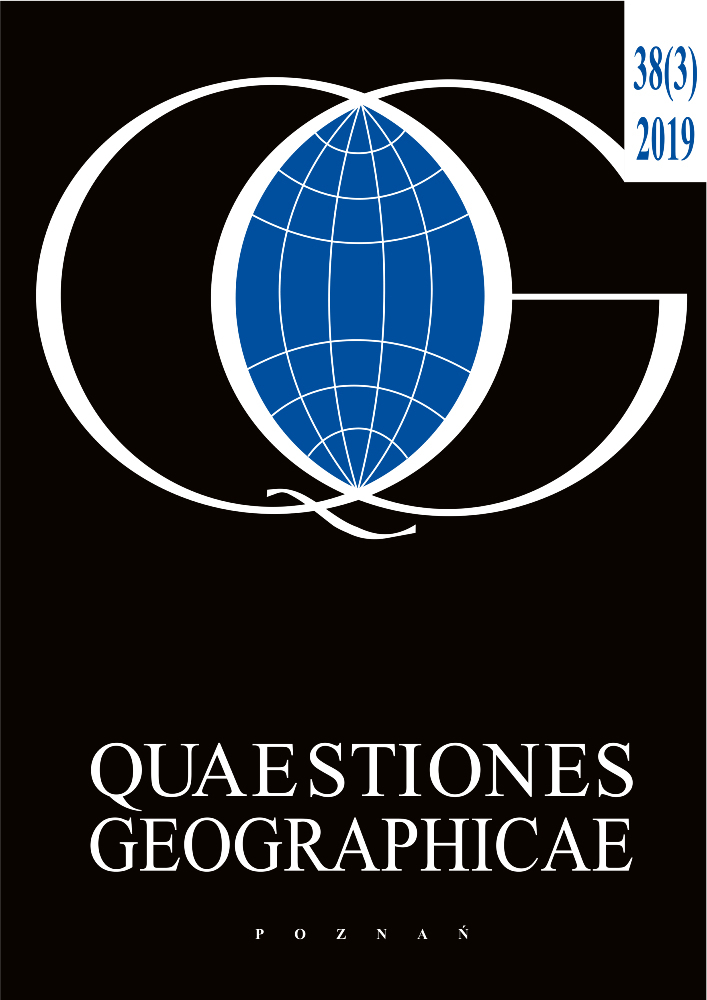Abstract
Coastal landforms are located in the interface zone between atmosphere, ocean and land surface systems formed by the geomorphic process of erosion, depositional, and subsidence. Studying the dynamics of coastal landform change is important for tracing the relationship between coastal landform changes and tidal flooding in the coastal areas of Pekalongan, Indonesia. The method of integrating remote sensing data with geographic information system (GIS) techniques has been widely used to monitor and analyze the dynamics of morphology change in coastal landform areas. The purpose of this study is to map the dynamics of landform change in the study area from 1978 to 2017 and to analyze its implications for the impact of tidal flooding. The results of the mapping and change analysis associated with coastal landforms can be classified into four landform types: beach, beach ridge, backswamp and alluvial plain. Changes in coastal morphology and landform topography affected by land subsidence and changes in land use/land cover have contributed to the occurrence of tidal flooding in the study area. Beach ridges perform an important role as natural levees which hold back and prevent the entry of seawater at high tide in coastal areas. A limitation of this study is that, as it focuses only on the physical aspects of coastal landform characteristics for one of the factors causing tidal flooding.
Funding
This paper is part of the research activities entitled The utilization of remotely sensed data to support analysis of flooding in Indonesia. This research was funded by the budget of DIPA LAPAN activities in 2017, Remote Sensing Application Center, Indonesian National Institute of Aeronautics and Space (LAPAN). Thanks go to Dr Mujio Sukir, Dr Indah Prasasti, Gigih Giarrastowo and Tival Gorodas and colleagues at the Remote Sensing Application Center, LAPAN for their support, discussions and suggestions. Landsat 5 MSS and Landsat 7 TM images were provided by the US Geological Survey (USGS), Landsat 8 OLI/ TIR images were provided by Remote Sensing Technology and Data Center, LAPAN and topographic maps were provided by the Indonesian Geospatial Information Agency (BIG).
References
Bemmelen R.W., 1949. The Geology of Indonesia. The Hague. Govt. Printing Office, Lolage.
Blaszczynski J.S., 1997. Landform characterization with geographic information systems. Photogrammetric engineering and remote sensing 63(2): 183–191.
Brooks S., 2007. Geomorphological processes. The London School of Economics and Political Science. University of London.
Chandrasekar N., Cherian A., Rajamanickam M., Rajamanickam, G.V., 2000. Coastal landform mapping between Tuticorin and Vaippar using IRS-IC data. Indian Journal of Geomorphology 5(1&2): 115–122.
Condon W.H., Pardyanto L., Ketner K.B., Amin T.C., Gafoer S., Samodra H., 1996. Geological Map of Sheet Banjarnegara and Pekalongan, Central Java. Bandung. Peta Geologi Lembar Banjarnegara dan Pekalongan, Jawa Tengah. Bandung.
Davidson-Arnott R.G.D., 2010. Introduction to coastal processes and geomorphology. United States of America by Cambridge University Press, New York.
Ekercin S., 2007. Coastline Change Assessment at the Aegean Sea Coasts in Turkey Using Multitemporal Landsat Imagery. Journal of Coastal Research 23(3): 691–698.
Erkkilä A., Kalliola R., 2004. Patterns and dynamics of coastal waters in multi-temporal satellite images: support to water quality monitoring in the Archipelago Sea, Finland. Estuarine, Coastal and Shelf Science 60(2): 165–177.
Ismail N.P., 2012. The dynamics of changes in the coastline of Pekalongan and Batang, Central Java. Thesis. Faculty of Fisheries and Marine Science. Dinamika perubahan garis pantai Pekalongan dan Batang, Jawa Tengah. Skripsi. Fakultas Perikanan dan Ilmu Kelautan. Institut Pertanian BogorBogor Agricultural University.
Kaliraj S., Chandrasekar N., Ramachandran K.K., 2017. Mapping of coastal landforms and volumetric change analysis in the south west coast of Kanyakumari, South India using remote sensing and GIS techniques. The Egyptian Journal of Remote Sensing and Space Sciences 20(2): 265–282. DOI: 10.1016/j.ejrs.2016.12.006.
Kasbullah A.A., Marfai M.A., 2014. Spatial modeling of tidal flood inundation and assessment of potential losses on paddy fields, case studies of coastal areas in Pekalongan District, Central Java. Geoedukasi 3(2): 83–91.
Kuleli T., Guneroglu A., Karsli F., Dihkan M. 2011. Automatic detection of shoreline change on coastal Ramsar wetlands of Turkey. Ocean Engineering 38(10): 1141–1149.
Lambin E.F., Strahlers A.H., 1994. Change-vector analysis in multitemporal space: a tool to detect and categorize land cover change processes using high temporal-resolution satellite data. Remote sensing of environment 48(2): 231–244.
Magesh N.S., Chandrasekar N., Kaliraj S., 2014. Mapping the coastal geomorphological landforms through Aster DEM and Landsat data – a case study from TuticorinVembar coastal stretch, southeast coast of India. Journal of Coastal Sciences 1(1): 1–5.
Marfai M.A., 2014. Impact of sea level rise to coastal ecology: a case study on the northern part of Java Island, Indonesia. Quaestiones Geographicae 33(1): 104–114. DOI: 10.2478/quageo-2014-0008.
Marfai M.A., King L., 2007. Monitoring land subsidence in Semarang, Indonesia. Environmental Geology 53: 651–659. DOI: 10.1007/ s00254-007-0680-3.
Marfai M.A., Almohammad H., Dey S., Santoso B., King L., 2007. Coastal dynamic and shoreline mapping: multi-sources spatial data analysis in Semarang Indonesia. Environmental Monitoring and Assessment 142(1–3): 297– 308. DOI: 10.1007/s10661-007-9929-2.
Maulana S., 2012. Spatial Modeling for Prediction of Inundation Area of Tidal Floods in Coastal Areas of the City of Jakarta (Case Study: Tanjungpriok District, North Jakarta). Thesis. Faculty of Geography, Gadjah Mada University.
Nashrrullah S., Aprijanto, Pasaribu J.M., Hazarika M.K., Samarakoon L., 2013. Study on flood inundation in Pekalongan, Central Java. International Journal of Remote Sensing Earth Sciences 10(2): 76–83.
Rao D.P., 2002. Remote sensing application in geomorphology. Tropical ecology 43(1): 49–59.
Shalaby A., Tateishi R., 2007. Remote sensing and GIS for mapping and monitoring land cover and land-use changes in the Northwestern coastal zone of Egypt. Applied Geography 27(1): 28–41.
Verstappen H.Th., 1977. Remote Sensing in Geomorphology. Elseviers, Amersterdam.
Nayak S, Chauhan P, Chauhan HP, Bahuguna A, and Nath NA (1996) IRS-1C applications for coastal zone management. Current Science 70(7): 614–618.
Ward P.J., Marfai M.A., Yulianto F., Hizbaron D.R., Aerts J.C.JH., 2010. Coastal inundation and damage exposure estimation: a case study for Jakarta. Natural Hazards 56: 899–916.
Zhao B., Guo H., Yan Y., Wang Q., Li B., 2008. A simple waterline approach for tidelands using multi-temporal satellite images: A case study in the Yangtze Delta. Estuarine, Coastal and Shelf Science 77(1): 134–142.

